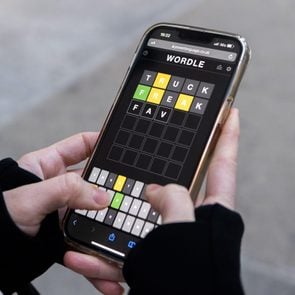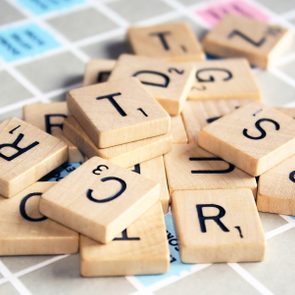How to Win Monopoly, According to a Monopoly World Champion
Updated: Nov. 22, 2023
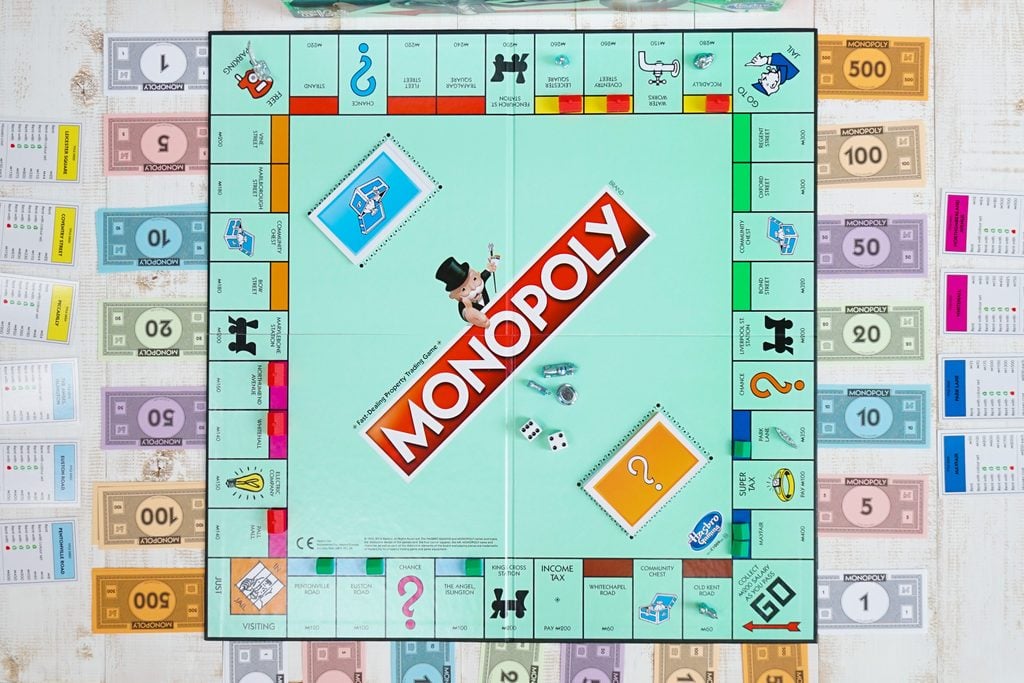
Houses or hotels? Orange properties or railroads? A world-champion Monopoly player offers his best strategies for how to win Monopoly, including which property groups have the highest ROI.
Among classic board games, it doesn’t get more iconic than Monopoly, the highest-selling board game of all time, and one of America’s oldest and most storied. It was conceived in 1903 by Elizabeth Magie, a game designer with a passion for economic reform. The Landlord’s Game, as it was then known, was designed to illustrate that financial success does not have to involve bankrupting one’s competition, according to Mary Pilon, author of The Monopolists, the New York Times bestselling book on the game’s history. However, since Hasbro’s predecessor, Parker Brothers, began mass marketing the real-estate-themed game as Monopoly in 1935, the question of how to win Monopoly has had one answer and one answer only: Crush thine opponent(s) in ruthless, capitalistic fashion.
It does require at least a modicum of luck though. As Monopoly world champion Nicolò Falcone humbly admitted, “If I play you, it’s not certain I will win.” Of course, that’s true of all strategy games that involve more than one opponent (Monopoly is for two to eight players). Nevertheless, just as there are ways to improve your luck in the game of life, there are hacks by which you can outsmart your opponents when playing the game of Monopoly. Fortunately for would-be Monopolists, Falcone knows them all and is willing to spill the tea. Who’s ready to learn how to win Monopoly?
Get Reader’s Digest’s Read Up newsletter for more more games, humor, cleaning, travel, tech and fun facts all week long.
What are the best strategies to win Monopoly
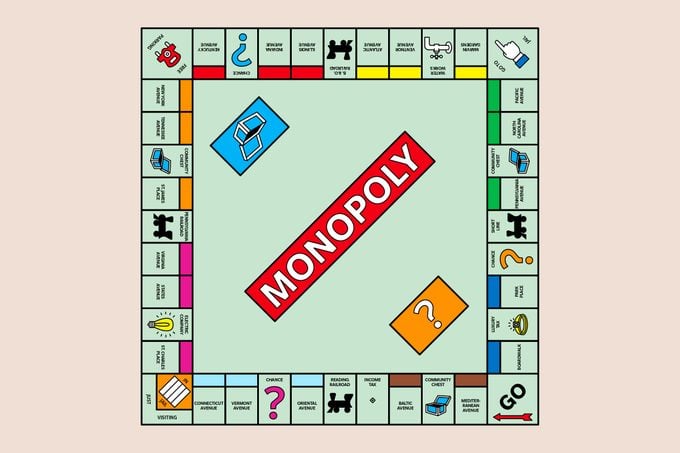
Learning how to win Monopoly begins with understanding how the game works. Monopoly involves moving clockwise around a 40-square game board. Twenty-two squares represent real estate properties divided into eight color-coded groups, each progressively more expensive to acquire than the one before it. When one player acquires all in a color group (i.e., a “monopoly”), they may “develop” the properties by purchasing houses and hotels. Another four squares represent railroads. Two are utilities. Owning all four railroads or both utilities offers another form of monopoly.
Initially, all 28 properties are available for sale from the bank (of which one player assumes the role). Once owned, all properties generate rent payable by non-owners who land on them. When a monopoly is owned, the rent increases. The more developed a property, the higher the rent goes—and by leaps and bounds, it’s worth noting.
As important as property ownership is in this game, you’ll also need to keep enough money on hand to pay rent to other players when you land on their properties. Failing to do so can bankrupt you, which takes you out of the game. In other words, Monopoly involves a carefully calibrated balance of saving and spending. And unlike winning tic-tac-toe or winning Connect 4, your order of play doesn’t typically affect your success. The following strategies can help you accomplish that. Because they work best when used together, for winning results, you’ll want to adopt them all.
No house rules
At-home Monopoly gameplay tends to be dictated by informal rules passed down from generation to generation, Pilon says. But like UNO and Scrabble, Monopoly favors those who know and play by the official rules. First and foremost, only playing by the official rules helps keep gameplay at under two hours, which is important, because your unwavering focus is a critical Monopoly-winning strategy.
Keith Tostado, director of the Emmy Award–winning documentary Under the Boardwalk: The Monopoly Story, has interviewed a plethora of Monopoly national and world champions and witnessed his share of high-stakes Monopoly matches. By way of example, he points out that “if a player lands on your property and you fail to ask them for rent before the next roll of the dice, you’ve waived your right.” Another official rule that helps keep gameplay brisk is that you don’t have to wait for your “turn” to transact business. Rather, you can buy houses for your properties, for example, or mortgage a property, every time the dice is rolled by any player (but after the other player has made their move).
Another reason to stick to the official rules? All these how-to-win-Monopoly strategies presume that you’ll be playing by said rules. And good news: Every Monopoly game Hasbro sells comes with them, and they’re a pretty quick read.
Embrace auctions, trading and mortgaging properties
Most Monopoly players are aware that when you land on an unowned property, you can purchase it from the bank. What many don’t know is that every property is available via auction from the bank—once any player has landed on it and opted not to purchase it. And as you’re probably picking up, it’s in your best interest to scoop up any and all properties that you can. Whether you’ll want to keep them for the duration of the game, however, depends on various factors discussed below. And that brings us to the mortgaging and trading of properties.
Between rolls of the dice, you can always turn any property into cash by mortgaging it to the bank. Mortgaging may come in handy if you find yourself low on cash. The only catch is that properties don’t generate rent while mortgaged. But as you’ll discover, some properties are worth more to you as cash than as rent-generators. Between rolls, you can also negotiate deals with other players to trade and/or sell properties. That can, and likely will, come in handy, given that movement around the board is dictated almost solely by chance.
Understand players’ movement around the board
Although Monopoly gameplay is strategic, movement around the board is dictated by various elements of chance, which also makes it a great online board game. The first is the roll of a pair of six-sided dice. Each roll yields 36 possible combinations, although each will dictate only 11 possible moves forward (i.e., 2 through 12). Of these, you’re most likely to roll a 7 “because there are so many combinations that will get you there,” Falcone points out. By the same reasoning, you’re also more likely to roll a 6 or an 8 than, say, a 2 or a 12.
In addition to rolling the dice, there are other chance-dictated ways of moving around the board. For example, when a player lands on one of the six “Chance” or “Community Chest” squares, they’re compelled to draw a card from the respective stack. That card might dictate skipping the rest of the squares to pass “Go” (and collect $200), but it could also send you to “Jail” without passing “Go.” Another product of chance: Each time you roll a double, you’ll be compelled to roll again—up to three times, at which point you go directly to “Jail.” In the meantime, rolling two doubles can land you “somewhere completely unexpected,” Pilon observes. The upshot is that some of the board squares are more likely to be landed upon than others. And that, of course, brings us to the heat map.
Know the heat map
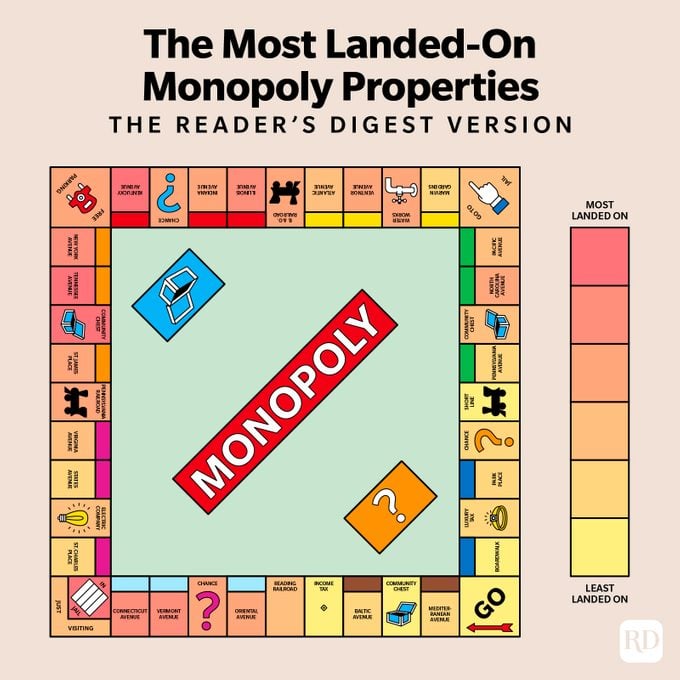
The probability of landing on any given Monopoly board square was solved years ago by what Monopoly experts and computer geeks alike refer to as the “heat map.” If you can commit it to memory, more power to you. But doing so isn’t a must, provided you know the following.
According to Falcone and the heat map, the orange properties are among the most landed-upon squares on the entire Monopoly board (“St. James Place,” “Tennessee Avenue” and “New York Avenue”). The only other square with comparable foot traffic probability is “Jail.” So while many experts have different strategies on how to win Monopoly, most agree on one thing: The best properties to buy in Monopoly are the orange ones.
Buy orange properties
An orange monopoly not only offers more opportunities to collect rent (they’re landed upon most often), but it also means you won’t be paying rent every time you land there. Moreover, monopolizing the orange properties means you can develop them with houses, which offers a particularly good return on investment (more on that below). After the orange property group, the property groups most likely to be landed upon are the light blue, red, yellow, then green, in that order. The dark blue (“Park Place” and “Boardwalk”) and brown (“Mediterranean Avenue” and “Baltic Avenue”) property groups, both of which comprise only two properties, are the least likely to be landed upon. The pink property group is just slightly better in terms of foot traffic probability.
Acquire properties early and often
“How to win monopoly, you ask? Turn down nothing,” quips Falcone, referring to his preferred acquisition strategy for his first few trips around the board. The name of the game is, after all, Monopoly. Monopolizing as much of the board as possible will always be to your benefit. The rationale is that owning a property doesn’t just earn you rent, it also allows you to mortgage and trade the property. And the more properties you own early, the less likely you are to pay rent—you’re not paying yourself if you land on it!
Know which property colors have a higher ROI
The financial term “return on investment” (ROI) refers to the amount of money you can earn on an investment compared with the cost of the investment itself. In the game of Monopoly, some property groups simply have better ROIs than others, and it’s easy to discern which these are, says Falcone. To wit, each real estate property comes with a “deed” card that lists its purchase price and cost of development (i.e., adding houses and hotels). That’s your investment. The deed also lays out the rent you can charge when another player lands on the property, and how much that rent goes up as you add houses and hotels. There’s your ROI.
If you compare the deed cards, as Falcone has, you’ll notice that on each side of the board, there are two property groups. The cost of development is the same for both. However, the rent is always higher for the second color group on each side (light blue, orange, yellow and dark blue). In other words, even without working out the math on your own, you can rest assured that the second color group on each side of the board will always offer a higher return on investment.
Acquire houses early and often
Falcone’s study of the deed cards has also made it abundantly clear that for all color groups, you’ll earn your greatest ROI by building exactly three houses on each property within the group. And you’ll be wise to do so as early in the game as possible. The reason? There are only 32 houses to purchase in any given Monopoly game. Once they’re purchased, there are no more, at which point the only way to acquire houses is to wait for another player to run into sufficient money woes and sell theirs for cash. Our experts refer to this phenomenon as the Monopoly “housing shortage.”
“One of the best investments you can make on all of the properties is to add the third house,” says Truman Collins, who created a massive probability analysis of Monopoly on his blog back in 2005. “That investment pays back pretty quickly.”
Now, if you’re worried about the high cost of building all those houses, it’s worth keeping in mind that while all houses are in limited supply, some can be acquired at lower cost than others. Indeed, the cost of a house increases significantly as you move around the board counterclockwise. For that reason, Pilon offers this clever trick for monopolizing the greatest number of houses for the lowest cost:
“Buy as many houses as you can on the brown and light blue properties,” Pilon advises. If you can manage to put four houses on each, you’ll have taken all but 12 of the available houses off the market while spending the fewest dollars possible. And let’s not forget that rent goes up considerably as you develop a property.
Don’t bother with hotels
Falcone’s study of the deed cards has also led to an interesting understanding of hotels. Although hotels can be purchased for the same amount of cash as houses and generate higher rent than houses, it doesn’t translate to a higher ROI. The reason is twofold. First, buying a hotel requires a payment of cash plus returning four of your houses to the bank. So, yes, your rent is now incrementally higher, but at the same time, those houses are now up for grabs by your opponents. And if someone goes ahead and buys them for one of their monopolies, your own exposure to higher rents increases, as we said earlier, by leaps and bounds.
Go to jail
The one square on the Monopoly board that every player is most likely to land on in any given turn is “Jail,” whether just visiting or as an inmate. The reason is that there are just so many ways to land there. But the most important takeaway about being in jail, according to Falcone, is that it’s a great place to hang out in the later stages of the game—when rents are likely high all over the board, potentially threatening your liquidity. Moreover, he points out that while you’re in jail, you can still collect rents, making the “Jail” square a win-win.
You can get out of jail by rolling a double, using a “Get out of jail free” card or paying a $50 fine. But consider not wasting your “free” card or $50 at the end of the game. The only time when being in jail isn’t such a great prospect is early in the game. That’s when a “Get out of jail free” card might come in handy, if you happen to have one. Otherwise, you might want to consider hoarding any such card you happen to draw.
Own utilities
In real life, utilities can be costly, often earning them a bad rap. They don’t fare much better in the Monopoly world. First off, they don’t promise much in the way of rental income, even if you own both. Moreover, in terms of their trading potential, you probably won’t be able to convince your opponents to buy them off you. But owning utilities is better than not owning them, for two reasons, per Falcone. One is that owning them means you won’t have to pay rent to anyone else when you land on them. The other is that if you’re low on cash, you can mortgage them. Although you won’t earn any rent while they remain mortgaged, it’s still better for your liquidity to eliminate any possibility of paying rent on them.
In other words, if you land on an unowned utility, go ahead and buy it.
Own all four railroads
Like utilities, railroads draw their fair share of disdain among Monopoly players. But take it from a Monopoly world champion: You don’t want to pass up an opportunity to own one, and even better, you should aim to own all four. “I like the railroads,” Falcone says. “Every time you roll the dice, you can reach a railroad from every single spot on the board. If you have four railroads, you get paid $200, and that’s equal to the rent when you own houses on the orange properties.”
While you’ll never win the game of Monopoly solely by becoming a railroad magnate, owning all the railroads can reliably generate rental income, and you can use that to buy more houses on other properties. “Buying and owning one railroad takes quite a bit of time to pay off, but if you own one and are able to buy or trade for a second, third or fourth, each of those pays off much more quickly, especially the third and fourth,” says Collins. “The same is true for the utilities, in that if you own one, getting the second one will make them both more valuable.”
What is the fastest way to win Monopoly?
If you’re wondering how to win Monopoly fast, you should first know that the fastest games beginning-to-end involve the greatest number of players (up to eight). This is not a game for two people if you want it to go quickly. Then, our experts universally recommend being the first to own a monopoly of developable properties and spending your money on houses, houses and more houses.
“Be the first to build houses,” Falcone says. “If one of your opponents lands on a three-house property, that, alone could bankrupt them.” Pilon puts it another way: “Leverage the housing shortage,” she advises. “Every house I buy prevents my opponent from building. And that improves your cash flow and makes the game go faster.”
How long does it take to win Monopoly?
When played according to the official rules, it should take no more than 90 minutes to two hours to win Monopoly. “If you change even one rule,” Falcone notes, “the game will take longer.” Likewise, in the interest of the most efficient gameplay, Pilon advises that all players pay close attention so as not to miss an opportunity to collect rent or to acquire a property. She also advises against injecting additional cash into the game. “Some people put $200 in the center of the board for those who land on ‘Free Parking,'” she says. But if you read Hasbro’s official rules, you’ll see that’s actually not a thing.
Common mistakes to avoid in Monopoly
There are certain mistakes you’ll want to avoid if you want to win Monopoly. Make sure to follow these expert-approved strategies:
- Don’t veer one iota from the official rules.
- Don’t turn down an opportunity to acquire a property.
- Don’t limit yourself to acquiring properties from the bank.
- Don’t wait to put houses on your properties.
- Don’t bother with hotels.
- Don’t assume that the pricier properties promise a higher ROI.
- Don’t assume that owning monopolies of cheaper properties can’t quell the competition.
About the experts
- Mary Pilon is the author of the New York Times bestselling book The Monopolists, the fascinating history of the game of Monopoly.
- Nicolò Falcone is the reigning Monopoly world champion, having won the honor in 2016 (the championships take place every four to six years but were postponed due to COVID-19). Falcone is also an attorney and a stand-up comedian who performs on Comedy Central Italia.
- Keith Tostado is the Emmy-winning director of the documentary film Under the Boardwalk: The Monopoly Story. He also works as a financial services representative with New York Life.
- Truman Collins created a large-scale probability analysis of the game of Monopoly on his blog in 2005, called Probabilities in the Game of Monopoly.
Sources:
- M/C Journal: “Why Monopoly Monopolises Popular Culture Board Games”
- Fun.com: “The Evolution of Board Games in North America”
- VICE: “10 Essential Tips from a ‘Monopoly’ World Champion”

